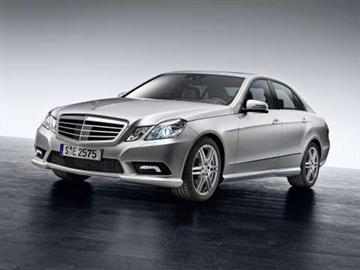|
Home | News | Road Tests | ||||||||||||
All-new Mercedes-Benz E-Class Awarded Environmental Certificate by TÜV Süd
Home > News > Mercedes-Benz 10th June, 2009The environmental compatibility of the all-new Mercedes-Benz E-Class has now been confirmed by the independent examiners at the German organisation TÜV Süd. The E-Class received the much sought-after environmental certificate according to ISO standard 14062. This award honours the commitment of the Daimler group to comprehensive environmental protection, which is firmly embedded in the operating guidelines for the entire corporation. The environmental certificate is based on an exhaustive eco-balance for the Mercedes-Benz E-Class, in which every environment-related aspect is assessed and documented. In addition to the all-new E-Class, Mercedes-Benz A-, B-, C- and S-Class have already received environmental certification from TÜV Süd. Last month the GLK was the first Mercedes-Benz SUV to receive this coveted award. In the development on the all-new Merceds-Benz E-Class, environmental certification of this model involved the examination of more than 40,000 individual, environment-related processes, which were analysed, quantified and assessed to produce an all-round eco-profile. This profile forms the basis for the environmental certificate granted by TÜV Süd. For the E-Class - as in the case of all the other certificated Mercedes-Benz model series - this work began with the environmentally compatible product development process known as "Design for Environment" (DfE). Integrating "DfE" into the development process ensured that all environment-related aspects were already taken into account during the very earliest development phase. Special "DfE" teams made up of engineers from a wide range of specialist departments ensured compliance with the declared environmental aims, for example in the areas of eco-balancing, disassembly and recycling planning, materials and process engineering, design and production. Chief Environmental Officer of Daimler AG, Professor Herbert Kohler: “Daimler AG is an environment-oriented automobile company, and therefore considers itself to have particular responsibilities in this regard.” “We analyse the environmental compatibility of our models over their entire lifecycle - from production and many years of use right up to eventual recycling and disposal”. “This goes well beyond the legal requirements. These analyses not only provide the basic data for the environmental certification of the E-Class, for at the same time these detailed studies reveal further potentials which are used intensively in our research and development work,” he said. Environmental compatibility improved versus the preceding model series Considering the entire lifecycle of the E-Class from production and 250,000 kilometres of operation to final disposal, the new model produces 14 per cent fewer CO2 emissions than its predecessor at the time of market launch in 2002. With respect to total nitrogen oxide emissions the E-Class is even more advantageous, as the reduction compared to the preceding model is no less than 20 per cent. This is primarily due to the new engines with their significantly lower nitrogen oxide emissions. The overall energy balance is also positive, for over the entire lifecycle is has been possible to make 13 per cent primary energy savings versus the preceding model. This corresponds to the energy contained in 3,200 litres of petrol. Comprehensive environmental concept making consistent use of recycled and renewable raw materials The E-Class already meets the prescribed recycling rate of 95 per cent by weight which becomes mandatory from 1st January 2015. Even during the development phase, great attention was already paid to materials segregation and ease of disassembly for certain thermoplastic components such as the bumpers, wheel arches and the side member, underbody and engine compartment claddings.
All in all, 43 components with a total weight of 41.5 kilogrammes are made from recycled, high-quality plastics. This is an increase of 80 per cent in the weight of approved recycled components compared to the preceding model. Another aim was to obtain recycled materials from vehicle-related waste flows as far as possible, so as to provide closed loops. Example: the recycled material used for the front wheel arches consists of reprocessed vehicle components such as the housings of starter batteries and bumper claddings from the Mercedes-Benz Recycling System, as well as waste material from cockpit production. Some 44 components in the E-Class with a total weight of around 21 kilogrammes are produced using natural materials. The boot flooring is made from a cellular cardboard structure, for example, and for fuel tank ventilation the engineers at Mercedes have also opted for a natural material. Coke obtained from olives is used as an activated charcoal filter. This open-pored material absorbs hydrocarbon emissions, and the filter regenerates itself automatically during vehicle operation. Renewable raw materials also play an important part in the production of the seat upholstery fabrics: around 25 per cent of their content is pure sheep's wool. This natural material has distinct comfort advantages over synthetic fibres, for wool not only has very good electrostatic properties, but also absorbs moisture more effectively, with resulting positive effects on seating comfort at high temperatures. Less is more: the new engines of the E-Class Three completely new four-cylinder diesel engines secure a leading position for the E-Class where environmental compatibility in day-to-day operations is concerned. These engines feature latest-generation common-rail direct injection, fast piezo-electric injectors and efficient exhaust gas recirculation. The E 250 CDI BlueEFFICIENCY with 150 kW and 500 Newton metres develops 25 per cent more torque than the comparable preceding model with a V6 diesel engine, but consumes around 23 per cent less fuel at 5.3 litres per 100 kilometres* (139 g CO2/km). The new diesel engine generation also powers the E 200 CDI BlueEFFICIENCY with 100 kW and the E 220 CDI BlueEFFICIENCY with 125 kW, both of which likewise consume 5.3 litres of fuel per 100 kilometres*. The diesel range is headed by the six-cylinder E 350 CDI BlueEFFICIENCY with an output of 170 kW, which consumes 0.5 litres less fuel per 100 kilometres than the preceding top diesel model. Quarter three of 2009 will see the introduction of the E 350 BlueTEC, which features the world's best emissions control based on SCR (Selective Catalytic Reduction) technology. In this case an aqueous urea solution is used to reduce the nitrogen oxides contained in the exhaust gases of the diesel engine. The 155 kW version already meets the EU6 emission standard planned for 2014. All the other engine variants in the E-Class comply with the EU5 standard. Mercedes-Benz equips the BlueEFFICIENCY petrol models E 200 CGI and E 250 CGI with the newly developed four-cylinder direct-injection engine with a displacement of 1.8 litres, turbocharging and variable intake and exhaust camshafts. The E 200 CGI BlueEFFICIENCY (135 kW) is equipped with the ECO start/stop function as standard, and consumes only 6.8 litres of premium petrol per 100 kilometres*. This equates to 159 grammes of CO2 per kilometre. The E 250 CGI BlueEFFICIENCY (150 kW), which has an automatic transmission as standard, develops a maximum torque of 310 Newton metres and consumes 7.3 litres per 100 kilometres*. This corresponds to 174 grammes of CO2 per kilometre. The engine range also includes the E 350 CGI BlueEFFICIENCY with direct petrol injection (215 kW) and
the top-of-the-line E 500 (285 kW) with a V8 unit.
The low Cd value of 0.25 – which makes the E-Class the world's most aerodynamically efficient luxury saloon – also helps to lower fuel consumption. This value is four per cent lower than that of the preceding model, which in practical terms means that at a German motorway speed of 130 km/h, there is a fuel saving of around 0.25 litres per 100 kilometres. The aerodynamics have for example, been improved by an automatically controlled radiator shutter, which regulates the airflow into the engine compartment as required. The all-new Mercedes-Benz E-Class sedan and coupé will be released in Australia in August. Once details of the specifications for Australian models are released, an announcement will be published by Next Car. | ||||||||||||
More Mercedes-Benz News ..... here About | Car Clubs | Home | News | Road Ramblings | Road Tests | Subscribe | Top Drive © 2009 All rights reserved. Next Car Pty. Ltd. |




